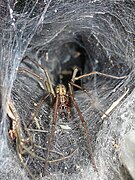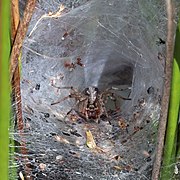Agelenidae
| Funnel weavers Temporal range:
| |
|---|---|

| |
| Grass spider (Agelenopsis sp.), female | |

| |
| Hobo spider ( E. agrestis )
| |
| Scientific classification | |
| Domain: | Eukaryota |
| Kingdom: | Animalia |
| Phylum: | Arthropoda |
| Subphylum: | Chelicerata |
| Class: | Arachnida |
| Order: | Araneae |
| Infraorder: | Araneomorphae |
| Family: | Agelenidae C. L. Koch, 1837 |
| Diversity | |
| 92 genera, 1374 species | |

| |
The Agelenidae are a large family of spiders in the suborder Araneomorphae. Well-known examples include the common "grass spiders" of the genus Agelenopsis. Nearly all Agelenidae are harmless to humans, but the bite of the hobo spider (Eratigena agrestis) may be medically significant, and some evidence suggests it might cause necrotic lesions,[1] but the matter remains subject to debate.[2] The most widely accepted common name for members of the family is funnel weaver.[3]
Description
The body length of the smallest Agelenidae spiders are about 4 mm (0.16 in), excluding the legs, while the larger species grow to 20 mm (0.79 in) long. Some exceptionally large species, such as
Agelenids have eight eyes in two horizontal rows of four. Their cephalothoraces narrow somewhat towards the front where the eyes are. Their abdomens are more or less oval, usually patterned with two rows of lines and spots. Some species have longitudinal lines on the dorsal surface of the cephalothorax, whereas other species do not; for example, the hobo spider does not, which assists in informally distinguishing it from similar-looking species.[4]
Biology

Most of the Agelenidae are very fast runners, especially on their webs. With speeds clocked at 1.73 ft/s (0.53 m/s), the
Agelenids build a flat sheet of nonsticky web with a funnel-shaped retreat to one side or occasionally in the middle, depending on the situation and species. Accordingly, "funnel weaver" is the most widely accepted common name for members of the family, but they should not be confused with the so-called "funnel-web tarantulas" or "funnel-web spiders" of mygalomorph families.[3]
The typical hunting mode for most sheet-building Agelenidae is similar to that of most other families of spiders that build sheet webs in the open, typically on grass or in
Like any fast-running spider, the Agelenidae possess good vision, and are generally photosensitive (i.e. react to changes in the light), so they can successfully retreat upon perceiving a larger threat's shadow approaching. Some are also sensitive to wind blows, and can retreat before the prey even spots them. Males are less successful ambushers than females, so prefer to roam around and wander to new areas, rather than stay in one single web. In September, males of outdoors species (such as Agelenopsis and Agelena) can seek refuge within houses, usually nesting on or underneath outer windowsills, or also around the porch door. These spiders often are neither pest controllers nor pests themselves; they are very selective in their prey, and do not consume large quantities; also, they are immune to intimidation and come back to their webs even after being disturbed, unless they are completely destroyed.
Parasocial species
The type genus, Agelena, includes some parasocial spiders that live in complex communal webs in Africa. The best known of these is probably A. consociata. Social behaviour in these spiders comprises communal web-building, cooperative prey capture, and communal rearing of young. No trophallaxis occurs, though, nor does any true eusociality such as occurs in the social Hymenoptera (ants, bees, and wasps); for example, the spiders have no castes such as sterile workers or soldiers, and all females are reproductive.[8]
Medical significance
Only one species of agelenid has become prominent as a putative cause of a significant frequency of necrotic arachnidism; this is the hobo spider, Eratigena agrestis.[4] This perception arose when the species was accidentally introduced to the United States in the mid-20th century and propagated rapidly in several regions. It is a fairly large, rapidly moving spider, so accordingly alarms many people.[9] A few cases of bites have been reported in Southern California by the desert grass spider, Agelenopsis aperta, that resulted in symptoms, but determining whether these cases were confused with similar-looking spiders is difficult.[10]
Genera
As of January 2023[update], the World Spider Catalog accepts these genera:[11]
- Acutipetala Dankittipakul & Zhang, 2008 — Thailand
- Aeolocoelotes Okumura, 2020 — Japan
- Agelena Walckenaer, 1805 — Africa, Asia, Italy
- Agelenella Lehtinen, 1967 — Yemen
- Agelenopsis Giebel, 1869 — North America, Ukraine, Asia
- Ageleradix Xu & Li, 2007 — China
- Agelescape Levy, 1996 — Asia
- Ahua Forster & Wilton, 1973 — New Zealand
- Allagelena Zhang, Zhu & Song, 2006 — Asia
- Alloclubionoides Paik, 1992 — Asia
- Asiascape Zamani & Marusik, 2020 — Iran
- Aterigena Bolzern, Hänggi & Burckhardt, 2010 — China, Italy, France
- Azerithonica Guseinov, Marusik & Koponen, 2005
- Bajacalilena Maya-Morales & Jiménez, 2017 — Mexico
- Barronopsis Chamberlin & Ivie, 1941 — Cuba, United States
- Benoitia Lehtinen, 1967 — Asia, Africa, Spain
- Bifidocoelotes Wang, 2002 — China
- Cabolena Maya-Morales & Jiménez, 2017 — Mexico
- Calilena Chamberlin & Ivie, 1941 — United States, Mexico
- Callidalena Maya-Morales & Jiménez, 2017 — Mexico, United States
- Coelotes Blackwall, 1841 — Asia, Europe, Mexico
- Coras Simon, 1898 — United States, Canada, Korea
- Curticoelotes Okumura, 2020 — Japan
- Dichodactylus Okumura, 2017 — Japan
- Draconarius Ovtchinnikov, 1999 — Asia
- Eratigena Bolzern, Burckhardt & Hänggi, 2013 — North America, Europe, Algeria, Asia
- Femoracoelotes Wang, 2002 — Taiwan
- Flexicoelotes Chen, Li & Zhao, 2015 — China
- Gorbiscape Zamani & Marusik, 2020 — Western Mediterranean, Tajikistan
- Griseidraconarius Okumura, 2020 — Japan
- Guilotes Zhao & S. Q. Li, 2018 — China
- Hadites Keyserling, 1862 — Croatia
- Hengconarius Zhao & S. Q. Li, 2018 — China
- Himalcoelotes Wang, 2002 — Nepal, Bhutan, China
- Histopona Thorell, 1869 — Europe
- Hoffmannilena Maya-Morales & Jiménez, 2016 — Mexico, Guatemala
- Hololena Chamberlin & Gertsch, 1929 — United States, Canada, Mexico
- Huangyuania Song & Li, 1990 — China
- Huka Forster & Wilton, 1973 — New Zealand
- Hypocoelotes Nishikawa, 2009 — Japan
- Inermocoelotes Ovtchinnikov, 1999 — Europe
- Iwogumoa Kishida, 1955 — Asia
- Jishiyu Lin & Li, 2023 — China
- Kidugua Lehtinen, 1967 — Congo
- Lagunella Maya-Morales & Jiménez, 2017
- Leptocoelotes Wang, 2002 — Taiwan
- Lineacoelotes Xu, Li & Wang, 2008 — China
- Longicoelotes Wang, 2002 — China, Japan
- Lycosoides Lucas, 1846 — Africa, Azerbaijan, Spain
- Mahura Forster & Wilton, 1973 — New Zealand
- Maimuna Lehtinen, 1967 — Asia, Greece
- Malthonica Simon, 1898 — Greece, Portugal, France
- Melpomene O. Pickard-Cambridge, 1898 — North America, Central America
- Mistaria Lehtinen, 1967 — Kenya, Yemen
- Neorepukia Forster & Wilton, 1973 — New Zealand
- Neotegenaria Roth, 1967 — Guyana
- Neowadotes Alayón, 1995 — Hispaniola
- Nesiocoelotes Okumura & Zhao, 2022 — Japan
- Notiocoelotes Wang, Xu & Li, 2008 — China
- Novalena Chamberlin & Ivie, 1942 — North America, Central America, Trinidad
- Nuconarius Zhao & S. Q. Li, 2018 — China
- Olorunia Lehtinen, 1967 — Congo
- Oramia Forster, 1964 — New Zealand, Australia
- Oramiella Forster & Wilton, 1973 — New Zealand
- Orumcekia Koçak & Kemal, 2008 — China, Vietnam
- Papiliocoelotes Zhao & Li, 2016 — China
- Paramyro Forster & Wilton, 1973 — New Zealand
- Persilena Zamani & Marusik, 2020 — Iran
- Persiscape Zamani & Marusik, 2020 — Western Asia, Greece
- Pireneitega Kishida, 1955 — Asia, Europe
- Platocoelotes Wang, 2002 — China, Japan
- Porotaka Forster & Wilton, 1973 — New Zealand
- Pseudotegenaria Caporiacco, 1934 — Libya
- Robusticoelotes Wang, 2002 — China
- Rothilena Maya-Morales & Jiménez, 2013 — Mexico
- Rualena Chamberlin & Ivie, 1942 — United States, Mexico
- Sinocoelotes Zhao & Li, 2016 — China, Thailand
- Sinodraconarius Zhao & S. Q. Li, 2018 — China
- Spiricoelotes Wang, 2002 — China, Japan
- Tamgrinia Lehtinen, 1967 — India, China
- Tararua Forster & Wilton, 1973 — New Zealand
- Tegecoelotes Ovtchinnikov, 1999 — Asia
- Tegenaria Latreille, 1804 — Europe, Asia, Africa, North America, Oceania, South America, Jamaica
- Textrix Sundevall, 1833 — Asia, Europe, Ethiopia
- Tikaderia Lehtinen, 1967 — Himalayas
- Tonsilla Wang & Yin, 1992 — China
- Tortolena Chamberlin & Ivie, 1941 — United States, Mexico, Costa Rica
- Troglocoelotes Zhao & S. Q. Li, 2019 — China
- Tuapoka Forster & Wilton, 1973 — New Zealand
- Urocoras Ovtchinnikov, 1999 — Europe, Turkey
- Vappolotes Zhao & S. Q. Li, 2019 — China
- Wadotes Chamberlin, 1925 — United States, Canada
A number of fossil species are known from Eocene aged Baltic amber, but their exact relationship with extant members of the clade is unclear.[12]
-
femaleE. atricaat the mouth of her retreat
-
Funnel web of an agelenid from Spain
-
Agelena labyrinthica female in web
-
A. labyrinthica, male (immature)
See also
References
- ISBN 978-1-4398-5085-5– via Google Books.
- PMID 21485377.
- ^ a b Breene; et al. (2003). Common Names of Arachnids (PDF) (5th ed.). Archived from the original (PDF) on 2006-09-27. Retrieved 2006-09-27.
- ^ a b Vetter, R. S., and A. L. Antonelli. 2002. How to identify (or misidentify) the hobo spider. Wash. St. Coop. Ext. Pest Leafl. Series No. 116
- PMID 22326455.
- ^ Gorb, S.N.; Barth, F.G. (1994). "Locomotor behavior during prey-capture of a fishing spider, Dolomedes plantarius (Araneae: Araneidae): galloping and stopping". The Journal of Arachnology. 22: 89–93.
- PMID 15066410.
- ISBN 978-0-19-981324-7.
- PMID 15573036.
- PMID 9832673.
- ^ "Family: Agelenidae C. L. Koch, 1837". World Spider Catalog. Natural History Museum Bern. Archived from the original on 2023-01-19. Retrieved 2023-01-19.
- S2CID 207937170.




